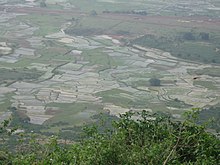Odisha semi-evergreen forests
| Orissa semi-evergreen forests | |
|---|---|
East Deccan moist deciduous forests | |
| Bird species | 215 |
| Mammal species | 59 |
| Geography | |
| Area | 8,600 km2 (3,300 sq mi) |
| Country | India |
| Coordinates | 20°19′N 85°58′E / 20.317°N 85.967°E |
| Conservation | |
| Conservation status | Critical/Endangered |
| Protected | 12.79% |
The Odisha semi-evergreen forests (also Orissa semi-evergreen forests) are a
Several of Odisha's largest cities, including Bhubaneswar, Cuttack, Puri, Chhatrapur, Kendrapara, and Bhadrak, lie within this ecoregion, and it has been extensively cleared for agriculture and urbanization. According to the WWF, 96% of the ecoregion's area has been cleared, and only 4% remains in the original semi-evergreen rain forest. Much of the remaining forest has been degraded by grazing and fuelwood harvesting.[1]
Flora
This section needs expansion. You can help by adding to it. (July 2019) |
-
Some coastal and river spots havemangroves.
-
Palm trees near the coast
-
Barunei Hill near Bhubaneswar
-
Inside a semi-evergreen (or semi-deciduous) forest in Odisha. Chandaka forest.
-
Special bamboo habitat in the forests. Chandaka forest.
-
Kapilash Forest Range, inland hills
Fauna

This ecoregion does not harbour any
The birdlife in the Odisha semi-evergreen ecoregion is quite diverse with 215 known species. The lesser florican (Eupodotis indica) is globally threatened and has found a sanctuary here.
-
Black buckin the fields
-
Saltwater crocodilesnear the coasts
-
Olive ridleyturtles lay eggs on the sandy beaches
-
Greater flamingos (Phoenicopterus ruber)
-
Lesser florican
Protected areas

Of the total ecoregion area, about 12.8% is protected.
- Balukhand-Konark Wildlife Sanctuary (70 km2)
- Chilka Wildlife Sanctuary (980 km2), including the Nalbana Bird Sanctuary
- Nandankanan Wildlife Sanctuary(50 km2)
Only tiny fragments of semi-deciduous forest remains in
Conservation

The original biome of this ecoregion is almost non-existing. According to older surveys, this has been the case since at least 1968. If left to itself, the habitat is believed to be replaced by tropical evergreen forests, not semi-evergreen forests.
Forest management
A study done by Reddy, Jha, & Dadhwal in this area is being used to shape environmental policies in India to protect
See also
References
- ^ Wikramanayake, Eric; Eric Dinerstein; Colby J. Loucks; et al. (2002). Terrestrial Ecoregions of the Indo-Pacific: a Conservation Assessment. Island Press; Washington, D.C. p 294
- PMID 22996824
External links
- "Orissa semi-evergreen forests". Terrestrial Ecoregions. World Wildlife Fund.
- "Ecoregions 2017". Resolve.
Geographical ecoregion maps and basic info.












